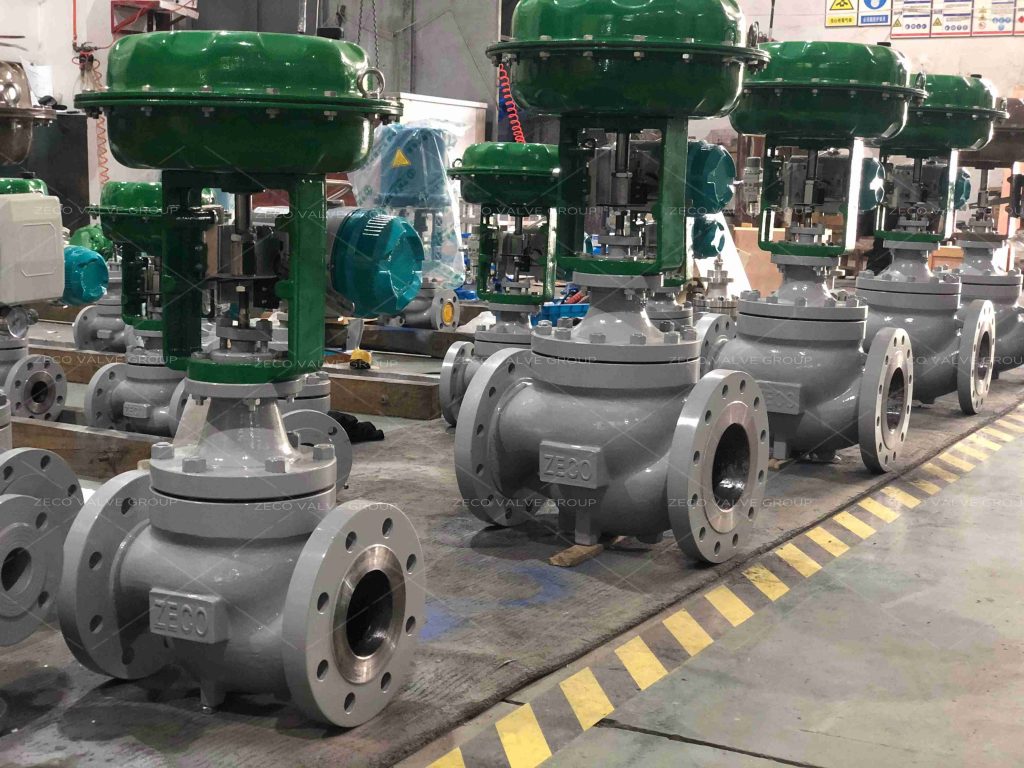
What is Cage Valve?
A more modern version of the globe valve design uses a piston-shaped plug inside a surrounding cage with ports cast or machined into it.
These cage-guided globe valves throttle flow by uncovering more or less of the port area in the surrounding cage as the plug moves up and down. The cage also serves to guide the plug so the stem need not be subjected to lateral forces as in a stem-guided valve design.
Specifications of Cage Guided Valve
- Size
- 2” through 24” (50 through 600 mm)
- Ratings & Connections
- Flanged: ANSI 150 – 2500, UNI-DIN 10 – 400
- Welded: BW or SW
- Screwed: NPT 2” (50 mm)
- Body Materials
- Carbon steel; stainless steel; chrome-moly
- Trim
- Balanced cage-guided trim; Lo-dB, anti-cavitation, and VRT (Variable Resistance Trim), single and multiple cages are available
- Inherent Characteristics
- linear or equal percentage
Features of the Cage Guided valve
Cage guided valves are widely used because of their many advantages. Let’s learn more about them together.
1. Easy to change the flow characteristics.
Sleeve adjustment valve in the fluid from the sleeve outward flow, known as the center to the outside flow direction. Conversely, the flow is called external to the center. However, it is usually used to flow from the lower part of the sleeve and out through the opening of the cage. There are 3, 4, or 6 throttle openings symmetrically located in the sleeve. The shape of the throttle openings is related to the desired flow characteristics. The flow characteristics of the control valve can therefore be easily changed by changing the sleeve (shape of the throttle opening).
2. Easy to install and maintain.
The valve seat is pressed against the valve body by the valve cover and is not threaded. Easy to install and maintain.
3. Interchangeability and versatility.
By replacing different sleeves, different flow coefficients and different flow characteristics can be obtained.
4. Noise reduction.
To reduce control valve noise, sleeve control valves are available as a type with noise-reducing inner parts. It has a sleeve and spool with a number of small holes. The small holes are used to increase the resistance. The velocity head is converted into kinetic energy to reduce noise. Typically, this type of sleeve control valve can reduce noise by more than 10 dB.
Therefore, they are widely used in applications where noise reduction is required. To reduce control valve noise, multi-stage pressure reduction methods can also be used. The total pressure drop at both ends of these noise-reducing control valves is distributed to all levels so that all levels do not cause the fluid to flash and cavitate.
This reduces the noise of the control valve and can weaken and prevent scouring and wear caused by flashing and cavitation. The bottom of the spool of the sleeve control valve is flat, so that if cavitation occurs, the impact from the rupture of the bubble does not act on the spool, but is absorbed by the medium itself. Therefore, the impact of cavitation of the sleeve adjustment valve is small, and the service life is long.
5. Leakage is larger than single-seated valves.
As a result of the sleeve and the spool between the graphite piston ring seal. After the long-term operation, the wear of the seal ring makes the leakage of the sleeve adjustment valve larger than that of the single-seated valve.
6. Easy maintenance.
The reverse sleeve control valve is particularly suitable for applications where the valve internals require frequent inspection and maintenance, as the spool can be removed from below.
7. Reduces the impact of unbalanced forces.
Usually, there are two types of sleeve adjustment valves, one is a balanced valve, and the other is an unbalanced valve. The balancing valve has a balancing hole on the spool so that the unbalance force on the spool is greatly reduced. At the same time, it has a damping effect, which is beneficial to the stable operation of the control valve. Therefore, this type of control valve is often used in applications with high differential pressure and low noise requirements.
We are a cage valve supplier, please feel free to contact us if you need them.
Related Tags :
Ten articles before and after
Single Seat vs Cage Guided Globe Control Valve | API 6D ball valve manufacturer
A Guide to Ball Valves(1) | API 6D ball valve manufacturer
A Guide to Ball Valves(2) | API 6D ball valve manufacturer
When Is a Butterfly Valve Used? | API 6D ball valve manufacturer
Why Choose Butterfly Valve? | API 6D ball valve manufacturer
Knife Gate Valve VS Gate Valve | API 6D ball valve manufacturer
Are the valves closed clockwise and opened counterclockwise? | API 6D ball valve manufacturer
Should We Use a Soft Seal or a Hard Seal for the Butterfly Valve? | API 6D ball valve manufacturer
Factors Affecting the Sealing Performance of Globe Control Valves | API 6D ball valve manufacturer
Difference Between Gate Valve And Butterfly Valve | API 6D ball valve manufacturer












